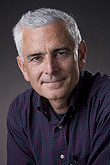Exploring interactions with space and time
 |
|
Craig Hogan
|
Craig Hogan, Director of the Center for Particle Astrophysics, wrote this column.
In the world according to quantum physics, particles move, interact and transform in space and time. Iconically, these processes are represented by Feynman diagrams, where interacting particle states appear as intersecting lines and squiggles.
In a Feynman diagram, spacetime is represented by the paper or blackboard it is written on. Although it belongs to the same physical world as the particles, it is not part of the diagram. That awkward relationship highlights a deep and longstanding ambiguity about the connection of the quantum world with space and time that lies at the heart of some of the deepest mysteries of physics.
Fermilab's accelerator experiments are close to a realization of the Feynman ideal: they collide particles at enormous energies, and scientists analyze the debris. In these extremely short-lived collisions, spacetime is not a player. It just sits there, a passive stage for the particle action. To probe the behavior of spacetime, we need to conduct experiments where the studied material extends over a much larger volume of space and duration in time, using particles whose interactions extend over very large systems. Our Cosmic Frontier experiments and projects do that in several very different ways, described below.
Dark matter:
We live in a galaxy that may be largely composed of invisible dark particles, and is both created and bound together by their gravity, a force which itself is a behavior of curved spacetime. Fermilab's dark matter searches (CDMS, COUPP, DarkSide and DAMIC) seek to detect these particles in the laboratory directly.
Dark energy:
We also live in a universe that is expanding. That expansion appears to accelerate due to the energy of empty space between the galaxies. Fermilab's Dark Energy Survey will use light from about a third of a billion galaxies to measure the structure and evolution of an enormous cosmic system with high precision. It will use this information about variations in space and time to probe the gravitational interactions of the cosmic vacuum, matter and energy on a grand scale.
Ultra-high-energy cosmic rays:
Fermilab also supports the Pierre Auger Observatory, which studies the highest-energy cosmic rays. These particles, some of which are a billion times more energetic than those produced at the Tevatron, may have been accelerated in magnetic maelstroms surrounding spinning black holes—distant, cataclysmic vortices of dynamic spacetime.
Quantum spacetime:
Fermilab is building the holometer, which will create very steady, intense waves of laser light extending about 40 meters in two different directions. The holometer uses measurements of correlated variations in the light in two close-by but separate systems to probe the quantum behavior of the underlying spacetime—to test directly whether it is just sitting there or is indeed an active participant in the quantum world.
These experiments explore the interactions of matter, energy, space and time in ways that complement Fermilab's accelerators.
|